Kingdom Plantae Family Lamiaceae Scientific name Perilla frutescens Rank Species | Order Lamiales Genus Perilla
L. Higher classification Perilla | |
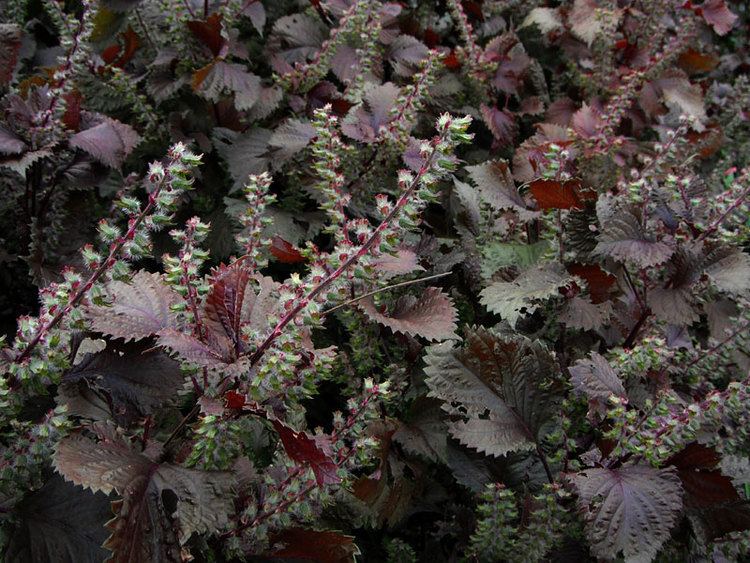 | ||
Similar Shiso, Elsholtzia ciliata, Plum blossom, Garlic chives, Welsh onion | ||
Perilla frutescens purpurea shiso
Perilla frutescens is the sole species of the monotypic genus Perilla in the mint family, Lamiaceae. This species encompasses several distinct varieties of Asian herb, seed, and vegetable crop, including shiso and deulkkae. The genus name Perilla is also a frequently employed common name ("perilla"), applicable to all varieties.
Contents
- Perilla frutescens purpurea shiso
- Perilla frutescens
- Taxa and synonyma
- China
- Japan
- Korea
- Laos
- Vietnam
- South Asia
- Ornamental use
- Use of oil
- References
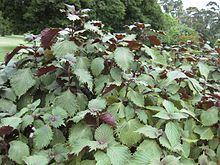
Perilla frutescens are annual plants with square stems and serrated leaves. The leaves are arranged in opposite pairs, and the leaf colours range from green to dark green, purple to purplish red. The flowers are white to purple and the seeds can be soft and hard, being white, grey, brown, and dark brown in colour. Perilla varieties are cross-fertile and intra-specific hybridization occurs naturally. Some varieties are considered invasive.
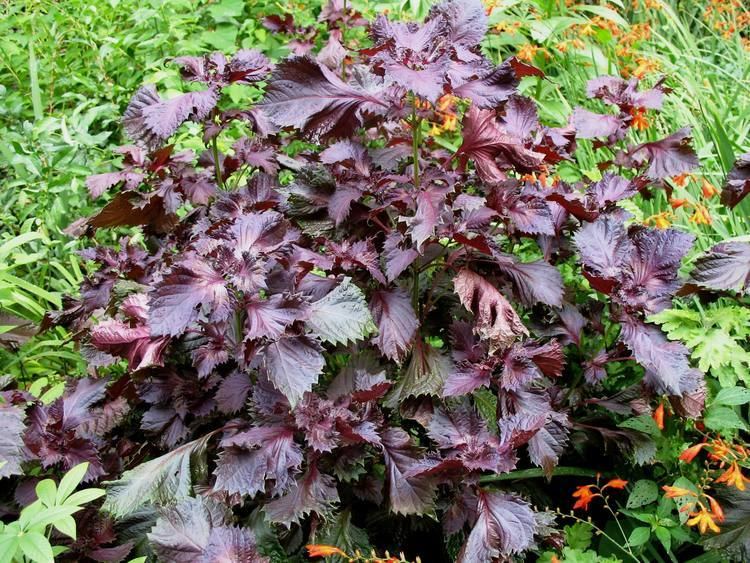
Perilla frutescens
Taxa and synonyma
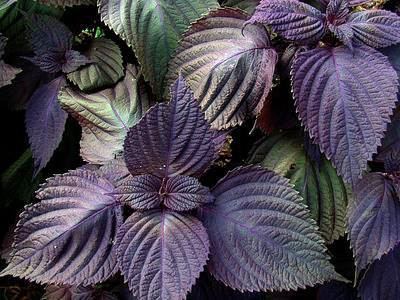
The classification of Perilla is confused, partly because botanists struggled with distinguishing the two distinct cultigens (as different species or variations). An early example of dividing the two cultigens into different species is found in Matsumura's nomenclature book in 1884, where the synonym P. arguta Benth. is applied to P. frutescens var. crispa, and the synonym P. ocymoides L. was applied to P. frutescens var. frutescens. However the species name P. ocymoides or P. ocimoides has been used to denote P. frutescens var. crispa for a long time, especially by the Japanese, so it should not be considered a synonym for either cultigen interchangeably.
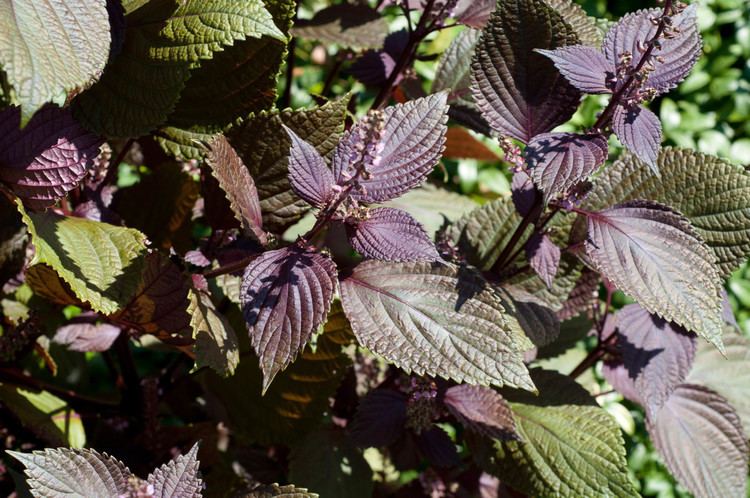
China
In Chinese, Perilla is called zisu (simplified Chinese: 紫苏; traditional Chinese: 紫蘇; pinyin: zǐsū). In Chinese cuisine, Perilla is fried in oil with garlic or ginger in the wok, and eaten as a dish with meals. During the Qing dynasty, the Manchu people's festival of "Food Extermination Day" (绝粮日) perilla was traditionally eaten by the Manchu bannermen under the Eight Banners system. The sū in the name zisu was the namesake for Mount Gusu, the peak which gave Suzhou its name. The red perilla has red leaves and used mostly in fish stews in China.
Japan
The Japanese name for the variety of perilla normally used in Japanese cuisine (Perilla frutescens var. crispa) is shiso (紫蘇). This name is already commonplace in US mass media's coverage of Japanese restaurants and cuisine. The Japanese call the green type aojiso (青紫蘇), or ooba ("big leaf"), and often eat the fresh leaves with sashimi (sliced raw fish) or cut them into thin strips in salads, spaghetti, and meat and fish dishes. It is also used as a savory herb in a variety of dishes, even as a pizza topping (initially it was used in place of basil). In the summer of 2009, Pepsi Japan released a new seasonal flavored beverage, Pepsi Shiso.
The Japanese shiso leaves grow in green, red, and bicolored forms, and crinkly (chirimen-jiso) varieties, as noted. Parts of the plants eaten are the leaves, flower and buds from the flower stalks, fruits and seeds, and sprouts.
The purple form is called akajiso (赤紫蘇, red shiso), and is used to dye umeboshi (pickled ume) red or combined with ume paste in sushi to make umeshiso maki. It can also be used to make a sweet, red juice to enjoy during summer.
Japanese use green shiso leaves raw with sashimi. Dried leaves are also infused to make tea. The red shiso leaf is not normally consumed fresh, but needs to be e.g. cured in salt. The pigment in the leaves turns from purple to bright red color when steeped in umezu, and is used to color and flavor umeboshi.
An inflorescence of shiso, called hojiso (ear shiso), is typically used as garnish on a sashimi plate; the individual flowers can be stripped off the stem using the chopstick, adding its flavor to the soy sauce dip. The fruits of the shiso (shiso-no-mi), containing fine seed (mericarp) about 1 mm or less in diameter (about the size of mustard seed), can be preserved in salt and used as a spice or condiment. Young leaves and flower buds are used for pickling in Japan and Taiwan.
The other type of edible perilla (Perilla frutescens var. frutescens or var. japonica) called egoma (荏胡麻) is of limited culinary importance in Japan, though this is the variety commonly used in nearby Korea. The cultivar is known regionally as jūnen in the Tohoku (northeast) regions of Japan. The term means "ten years", supposedly because it adds this many years to one's lifespan. A local preparation in Fukushima prefecture, called shingorō, consists of half-pounded unsweet rice patties, which are skewered, smeared with miso, blended with roasted and ground jūnen seeds, and roasted over charcoal. The oil pressed from this plant was once used to fuel lamps in the Middle Ages. The warlord Saitō Dōsan, who started out in various occupations, was a peddler of this type of oil, rather than the more familiar rapeseed oil, according to a story by historical novelist Ryōtarō Shiba.
Korea
Deulkkae seeds are either toasted and grounded into powder called dulkkaetgaru(들깻가루) or used to make perilla oil called deulgireum(들기름). Both the powder and the oil are used as important condiments in Korean cuisine.
The leaves, kkaennip(깻잎) are used fresh, dried or pickled. Kkaennip can be used as a herb or as a vegetable ingredient in the preparation of many dishes. It sometimes substitutes basil in Korean-style western food.
Laos
The purple leaves, called pak maengda (ຜັກແມງດາ), are strong in fragrance, but not ruffled. Lao also used them for Lao rice vermicelli, khao poon (ເຂົ້າປຸ້ນ), which is very similar to the Vietnamese bún. They are used as part of the dish for their fragrance.
Vietnam
Vietnamese cuisine uses a variety similar to the Japanese perilla, but with greenish bronze on the top face and purple on the opposite face. The leaves are smaller and have a much stronger fragrance. In Vietnamese, it is called tía tô, derived from the characters (紫蘇) whose standard pronunciation in Vietnamese is tử tô. It is usually eaten as a garnish in rice vermicelli dishes called bún and a number of stews and simmered dishes.
South Asia
In Nepal, Kumaun, and parts of India, it is called silam (सिलाम), thoiding (meitei), chhawhchhi (Mizo) and bhangira. Its seeds are roasted and ground with salt, chilis, and tomatoes to make a savoury dip/side dish or chutney.
China
Perilla is used in Traditional Chinese Medicine (TCM), and is indicated to ease the symptoms of the common cold. Perilla has been shown to stimulate interferon activity and thus, the body's immune system.
Ornamental use
The red-leaved shiso, in earlier literature referred to as Perilla nankinensis, became available to gardening enthusiasts in England circa 1855. By 1862, the English were reporting overuse of this plant, and proposing Coleus vershaeffeltii or Amaranthus melancholicus var. ruber made available by J. G. Veitch as an alternative.
It was introduced later in the United States, perhaps in the 1860s.
Use of oil
Perilla oil is made of the seeds of P. frutescens var. frutescens. It is well-established that perilla varieties are cross-fertile. The desired essential oil yield will be compromised if the seed for sowing becomes hybridized, and "it is very difficult to distinguish genuine perilla seed from hybrid seed".
Toasted perilla oil is usually for culinary use, mainly in Korean cuisine, while untoasted perilla oil was used used for non-culinary purposes: for lamps, for oilpaper, etc. The press cake remaining after pressing perilla oil is used as fertiliser or animal feed.
